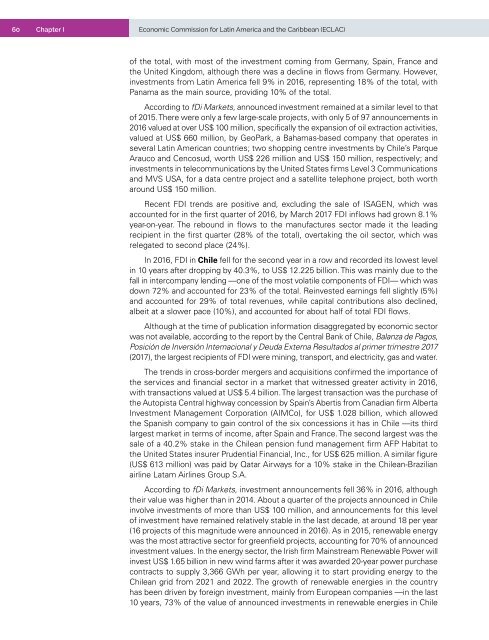Foreign Direct Investment in Latin America and the Caribbean 2017
This publication sets out and analyses the main foreign direct investment (FDI) trends in the countries of Latin America and the Caribbean. The 2017 edition shows that the region is at a difficult juncture. FDI inflows declined by 7.9% in 2016, to US$ 167.043 billion, representing a cumulative fall of 17.0% since the peak in 2011. The fall in commodity prices continues to affect investments in natural resources, sluggish economic growth in several countries has slowed the flow of market-seeking capital, and the global backdrop of technological sophistication and expansion of the digital economy has concentrated transnational investments in developed economies.
This publication sets out and analyses the main foreign direct investment (FDI) trends in the countries of Latin America and the Caribbean. The 2017 edition shows that the region is at a difficult juncture. FDI inflows declined by 7.9% in 2016, to US$ 167.043 billion, representing a cumulative fall of 17.0% since the peak in 2011. The fall in commodity prices continues to affect investments in natural resources, sluggish economic growth in several countries has slowed the flow of market-seeking capital, and the global backdrop of technological sophistication and expansion of the digital economy has concentrated transnational investments in developed economies.
You also want an ePaper? Increase the reach of your titles
YUMPU automatically turns print PDFs into web optimized ePapers that Google loves.
60 Chapter I Economic Commission for Lat<strong>in</strong> <strong>America</strong> <strong>and</strong> <strong>the</strong> <strong>Caribbean</strong> (ECLAC)<br />
of <strong>the</strong> total, with most of <strong>the</strong> <strong>in</strong>vestment com<strong>in</strong>g from Germany, Spa<strong>in</strong>, France <strong>and</strong><br />
<strong>the</strong> United K<strong>in</strong>gdom, although <strong>the</strong>re was a decl<strong>in</strong>e <strong>in</strong> flows from Germany. However,<br />
<strong>in</strong>vestments from Lat<strong>in</strong> <strong>America</strong> fell 9% <strong>in</strong> 2016, represent<strong>in</strong>g 18% of <strong>the</strong> total, with<br />
Panama as <strong>the</strong> ma<strong>in</strong> source, provid<strong>in</strong>g 10% of <strong>the</strong> total.<br />
Accord<strong>in</strong>g to fDi Markets, announced <strong>in</strong>vestment rema<strong>in</strong>ed at a similar level to that<br />
of 2015. There were only a few large-scale projects, with only 5 of 97 announcements <strong>in</strong><br />
2016 valued at over US$ 100 million, specifically <strong>the</strong> expansion of oil extraction activities,<br />
valued at US$ 660 million, by GeoPark, a Bahamas-based company that operates <strong>in</strong><br />
several Lat<strong>in</strong> <strong>America</strong>n countries; two shopp<strong>in</strong>g centre <strong>in</strong>vestments by Chile’s Parque<br />
Arauco <strong>and</strong> Cencosud, worth US$ 226 million <strong>and</strong> US$ 150 million, respectively; <strong>and</strong><br />
<strong>in</strong>vestments <strong>in</strong> telecommunications by <strong>the</strong> United States firms Level 3 Communications<br />
<strong>and</strong> MVS USA, for a data centre project <strong>and</strong> a satellite telephone project, both worth<br />
around US$ 150 million.<br />
Recent FDI trends are positive <strong>and</strong>, exclud<strong>in</strong>g <strong>the</strong> sale of ISAGEN, which was<br />
accounted for <strong>in</strong> <strong>the</strong> first quarter of 2016, by March <strong>2017</strong> FDI <strong>in</strong>flows had grown 8.1%<br />
year-on-year. The rebound <strong>in</strong> flows to <strong>the</strong> manufactures sector made it <strong>the</strong> lead<strong>in</strong>g<br />
recipient <strong>in</strong> <strong>the</strong> first quarter (28% of <strong>the</strong> total), overtak<strong>in</strong>g <strong>the</strong> oil sector, which was<br />
relegated to second place (24%).<br />
In 2016, FDI <strong>in</strong> Chile fell for <strong>the</strong> second year <strong>in</strong> a row <strong>and</strong> recorded its lowest level<br />
<strong>in</strong> 10 years after dropp<strong>in</strong>g by 40.3%, to US$ 12.225 billion. This was ma<strong>in</strong>ly due to <strong>the</strong><br />
fall <strong>in</strong> <strong>in</strong>tercompany lend<strong>in</strong>g —one of <strong>the</strong> most volatile components of FDI— which was<br />
down 72% <strong>and</strong> accounted for 23% of <strong>the</strong> total. Re<strong>in</strong>vested earn<strong>in</strong>gs fell slightly (5%)<br />
<strong>and</strong> accounted for 29% of total revenues, while capital contributions also decl<strong>in</strong>ed,<br />
albeit at a slower pace (10%), <strong>and</strong> accounted for about half of total FDI flows.<br />
Although at <strong>the</strong> time of publication <strong>in</strong>formation disaggregated by economic sector<br />
was not available, accord<strong>in</strong>g to <strong>the</strong> report by <strong>the</strong> Central Bank of Chile, Balanza de Pagos,<br />
Posición de Inversión Internacional y Deuda Externa Resultados al primer trimestre <strong>2017</strong><br />
(<strong>2017</strong>), <strong>the</strong> largest recipients of FDI were m<strong>in</strong><strong>in</strong>g, transport, <strong>and</strong> electricity, gas <strong>and</strong> water.<br />
The trends <strong>in</strong> cross-border mergers <strong>and</strong> acquisitions confirmed <strong>the</strong> importance of<br />
<strong>the</strong> services <strong>and</strong> f<strong>in</strong>ancial sector <strong>in</strong> a market that witnessed greater activity <strong>in</strong> 2016,<br />
with transactions valued at US$ 5.4 billion. The largest transaction was <strong>the</strong> purchase of<br />
<strong>the</strong> Autopista Central highway concession by Spa<strong>in</strong>’s Abertis from Canadian firm Alberta<br />
<strong>Investment</strong> Management Corporation (AIMCo), for US$ 1.028 billion, which allowed<br />
<strong>the</strong> Spanish company to ga<strong>in</strong> control of <strong>the</strong> six concessions it has <strong>in</strong> Chile —its third<br />
largest market <strong>in</strong> terms of <strong>in</strong>come, after Spa<strong>in</strong> <strong>and</strong> France. The second largest was <strong>the</strong><br />
sale of a 40.2% stake <strong>in</strong> <strong>the</strong> Chilean pension fund management firm AFP Habitat to<br />
<strong>the</strong> United States <strong>in</strong>surer Prudential F<strong>in</strong>ancial, Inc., for US$ 625 million. A similar figure<br />
(US$ 613 million) was paid by Qatar Airways for a 10% stake <strong>in</strong> <strong>the</strong> Chilean-Brazilian<br />
airl<strong>in</strong>e Latam Airl<strong>in</strong>es Group S.A.<br />
Accord<strong>in</strong>g to fDi Markets, <strong>in</strong>vestment announcements fell 36% <strong>in</strong> 2016, although<br />
<strong>the</strong>ir value was higher than <strong>in</strong> 2014. About a quarter of <strong>the</strong> projects announced <strong>in</strong> Chile<br />
<strong>in</strong>volve <strong>in</strong>vestments of more than US$ 100 million, <strong>and</strong> announcements for this level<br />
of <strong>in</strong>vestment have rema<strong>in</strong>ed relatively stable <strong>in</strong> <strong>the</strong> last decade, at around 18 per year<br />
(16 projects of this magnitude were announced <strong>in</strong> 2016). As <strong>in</strong> 2015, renewable energy<br />
was <strong>the</strong> most attractive sector for greenfield projects, account<strong>in</strong>g for 70% of announced<br />
<strong>in</strong>vestment values. In <strong>the</strong> energy sector, <strong>the</strong> Irish firm Ma<strong>in</strong>stream Renewable Power will<br />
<strong>in</strong>vest US$ 1.65 billion <strong>in</strong> new w<strong>in</strong>d farms after it was awarded 20-year power purchase<br />
contracts to supply 3,366 GWh per year, allow<strong>in</strong>g it to start provid<strong>in</strong>g energy to <strong>the</strong><br />
Chilean grid from 2021 <strong>and</strong> 2022. The growth of renewable energies <strong>in</strong> <strong>the</strong> country<br />
has been driven by foreign <strong>in</strong>vestment, ma<strong>in</strong>ly from European companies —<strong>in</strong> <strong>the</strong> last<br />
10 years, 73% of <strong>the</strong> value of announced <strong>in</strong>vestments <strong>in</strong> renewable energies <strong>in</strong> Chile


















